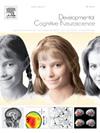Feeling left out in the Lunchroom: Neural mechanisms of ostracism vary across adolescence
IF 4.9
2区 医学
Q1 NEUROSCIENCES
引用次数: 0
Abstract
Ostracism (i.e., being ignored/excluded) can cause intense emotional reactions that detrimentally impact mental and physical health. Adolescents may be particularly susceptible to these negative consequences due to brain maturation and changing social priorities. To better understand how neural mechanisms of ostracism vary across development (i.e., age, puberty), the current study employed a pictorial adaptation of Hudac’s (2019) Lunchroom electroencephalography (EEG) task in a sample of 84 adolescents (aged 10–14 years). Results indicated unique effects across event-related potential amplitudes, including a reversed pattern (greater sensitivity to inclusion) for the P1, the “classic” ostracism effect (greater sensitivity to exclusion) for the N2, and classic effects when modulated by puberty for the P3. Source estimation identified different neural networks that were likely driving sensitivity to exclusion (e.g., amygdala, SCG, and IFG) or inclusion (e.g., ACC, cingulate, fusiform, insula, SPL, STG). Further, sensitivity to exclusion increased over pubertal development for P3 amplitude but over age for amygdala and IFG. Sensitivity to inclusion decreased over age for P1 amplitude and inclusion sensitive regions. The current study emphasizes the utility of using paradigms that isolate neural processes associated with ostracism while controlling for participant involvement.
感觉被遗忘在午餐室:在青春期,被排斥的神经机制各不相同
排斥(即被忽视/排斥)会引起强烈的情绪反应,对身心健康产生有害影响。由于大脑成熟和社会优先事项的变化,青少年可能特别容易受到这些负面后果的影响。为了更好地理解排斥的神经机制在不同的发育阶段(即年龄、青春期)是如何变化的,目前的研究在84名青少年(10-14岁)的样本中采用了Hudac(2019)的午餐室脑电图(EEG)任务的图片改编。结果表明,在事件相关电位振幅中存在独特的效应,包括P1的反向模式(对包含更敏感),N2的“经典”排斥效应(对排斥更敏感),P3的经典效应受青春期调节。源估计确定了不同的神经网络,这些神经网络可能驱动对排除(例如,杏仁核,SCG和IFG)或包含(例如,ACC,扣带回,梭状回,岛,SPL, STG)的敏感性。此外,P3振幅的排除敏感性随着青春期的发展而增加,而杏仁核和IFG的排除敏感性随着年龄的增长而增加。随着年龄的增长,P1振幅和包裹体敏感区域对包裹体的敏感性降低。目前的研究强调使用范例的效用,这些范例分离与排斥相关的神经过程,同时控制参与者的参与。
本文章由计算机程序翻译,如有差异,请以英文原文为准。
求助全文
约1分钟内获得全文
求助全文
来源期刊

Developmental Cognitive Neuroscience
NEUROSCIENCES-
CiteScore
7.60
自引率
10.60%
发文量
124
审稿时长
6-12 weeks
期刊介绍:
The journal publishes theoretical and research papers on cognitive brain development, from infancy through childhood and adolescence and into adulthood. It covers neurocognitive development and neurocognitive processing in both typical and atypical development, including social and affective aspects. Appropriate methodologies for the journal include, but are not limited to, functional neuroimaging (fMRI and MEG), electrophysiology (EEG and ERP), NIRS and transcranial magnetic stimulation, as well as other basic neuroscience approaches using cellular and animal models that directly address cognitive brain development, patient studies, case studies, post-mortem studies and pharmacological studies.
 求助内容:
求助内容: 应助结果提醒方式:
应助结果提醒方式:


